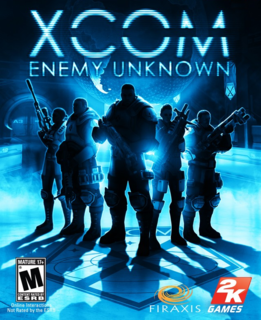INTRO:
Although the first XCOM reboot was lauded by most as having revived a subgenre of strategy and squad tactical games, its detractors pointed out that it lacks the complexity of the classic X-COM and UFO games. The Long War is intended to increase the complexity of the gameplay, including that of the Enemy Within expansion.
PREMISE:
At this time of writing, it has been established that many of the events that would happen in Enemy Unknown and Enemy Within is non-canon. The XCOM project that is the protagonist of the first XCOM reboot would never know victory canonically, because they did not prevail in the assault on the main base of XCOM.
That did not stop the creators of the Long War mod from changing quite a bit of lore to justify the changes to the gameplay. For the most part though, these differences are not significant enough to diverge from the premise of either Enemy Unknown or Enemy Within. They do not seem to be garrulous fan-fiction either.
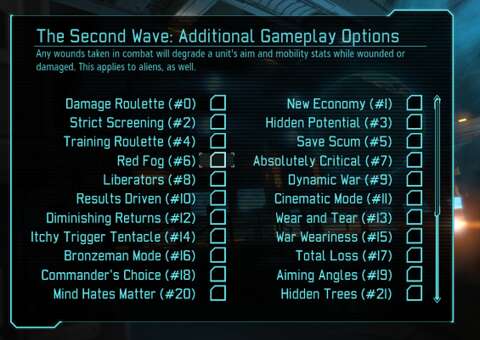
INSTALLATION:
That said, the Long War mod is surprisingly easy to apply; that some of its creators include employees of Firaxis at the time may have contributed to this ease. That said, any game-save that has been made with Long War content can only work with Long War-enabled game sessions. In other words, removing the mod would render these game-saves quite unusable.
NOT MANY FUNDAMENTAL CHANGES TO COMBAT:
At first glance, the mod does not seem to have changed much of the fundamentals of the tactical turn-based gameplay. The frustratingly fickle hit-or-miss attack rolls and critical chances are still there, as are variable damage ranges and scatter directions in the case of misses. Indeed, the mod begins with a mission that shows that not much has changed in this part of the gameplay, for better or worse.
The only major difference is that the player’s squad of operatives can be more than just six people now. This is just as well, because the mod throws more aliens at the player and more powerful ones too than the vanilla versions had.
The most significant changes in the tactical turn-based gameplay occur in the capabilities of the combatants, be they alien or human (or formerly human). These go beyond the changes that were implemented in the Enemy Within expansion. The rest of this article will expound on these.
CHANGES TO GEOSCAPE GAMEPLAY:
At first glance, the Geoscape has not changed much either. The main XCOM base is still an underground complex that has been built into a mountain. The main facilities have been made, but the player still needs to excavate spaces to make way for auxiliary facilities.
However, the minutia and what the player cannot see are where the differences are. For example, Satellite Uplinks and Nexuses no longer support as many Satelites as they had.
THE ALIENS HAVE THEIR OWN RULES:
In the vanilla games, the aliens are ultimately set-pieces and scripted events that happen in order to toss challenges at the player. They are not fundamentally any more different than the automated game-master in rogue-lite titles.
In the Long War mod, they have been given a CPU-controlled manager, not unlike the player, that decides on what the aliens can field and that would strive to improve their capabilities. In practice, this manager handles things that are considerably simpler than the things that the player would handle, e.g. the aliens’ manager do not need to worry about a roster of operatives.
The aliens’ incredible technology provides the “phlebotinum” story trope to wave away this difference. For example, even though the aliens would lose individuals left and right when opposing XCOM in the missions, their replacements would be more powerful than their predecessors anyway.
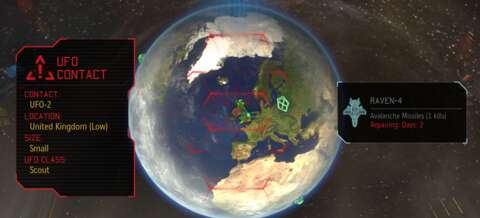
ALIENS ADVANCE AT XCOM’S EXPENSE:
Just as XCOM would advance at the aliens’ expense, the aliens would advance at XCOM’s expense. Any harm that the aliens would inflict on XCOM, including the killing of soldiers during missions, advances the aliens’ endeavor. This is in addition to a flat advancement that is guaranteed over time, the rate of which is dependent on the difficulty setting that the player has chosen.
That said, a poorly performing player – either due to lousy skill or bad luck, or both – would mean that the aliens would indubitably win. The Long War mod is indeed not for players who are not wise in their planning, nor for players who have black cats crossing their paths many times.
However, this also means that if the player had been able to consistently inflict misfortune on the aliens, then they can only field assets at the barest minimum relative to the length of the playthrough at the time. XCOM’s own advancement, which relies on taking things from the aliens, would be pared down too as a consequence.
SQUEEZING EXALT IS NO LONGER PROFITABLE:
In Enemy Within, defeating EXALT forces in the covert missions against the collaborators yield laser arms that can be confiscated for later sales to the Council of Nations. This made for relatively easy income. This is not the case in the Long War; the laser arms are destroyed upon the death of EXALT operatives; writers for the Long War justify this through the excuse that EXALT obtained the means of self-destructing weapons from the aliens.
ALIEN ASSETS – OVERVIEW:
The player would have to look into the documentation of the Long War on UFOPaedia to know the following. There is in-game documentation, but exact details are not presented to the player.
As mentioned earlier, the aliens’ manager have few things to worry about. These include the “research” level of the aliens, and their “resources”.
ALIEN RESEARCH:
The “research” level is the one that inexorably increases; it cannot be reversed, just like XCOM’s own research advancements. It is implemented in-game as a threshold meter; after certain levels have been reached, the aliens can field nastier things.
The aliens’ research level determines the quality and power of the minions that they can field. This is most noticeable in Sectoids and (especially) Thin Men. Sectoids gain more hitpoints and better skill with their light (albeit plasma-powered) arms, and Thin Men become next to impossible to hit with reaction and overwatch shots due to their acquisition of the Lightning Reflexes perk.
However, not all of these improvements are visible to the player. For one, information on the weapons and armor ratings of UFOs remains scant and obtuse, apparently due to limitations in the display of in-game details that the mod creators could not overcome.

ALIEN RESOURCES:
The aliens may have story-telling excuses for having their phlebotinum, but their “resource” level is the one that holds them back from simply overwhelming XCOM outright (at least in this mod; they certainly had in the backstory of the second game).
According to the writing that has been implemented via the mod, the aliens may have arrived at Earth with their incredible faster-than-light technology, but such technology still requires considerable consumption of resources. They are getting these resources from Earth itself, presumably from pillaging and abductions, and presumably from their own stores.
Gameplay-wise, the aliens cannot do anything that requires their resource level be beyond their current one. In order to raise their resource level, they must send out UFOs to harvest resources or abduct people. (The writing has also been changed to imply that their organic resources are obtained from rendering down the humans that they abducted.)
Only the simplest harvest missions, performed by the lightest of UFOs, can be done without regard to the resource level. This also means that the aliens can still do something even if their resource levels have been badly diminished.
That said, every in-game month, the aliens’ resource level resets to a certain level, as determined by their research level, if their previous resource level is below that. A higher research level means that this reset level is higher. Therefore, the aliens cannot be kept down in the long run; this also means that the aliens will eventually have something that the player can take, if the player has been consistently successful.
ALIENS MAINLY DO THINGS VIA UFOS:
In the vanilla game, missions may pop up randomly, or as predetermined by conditional scripts. In the Long War mod, most missions are generated via the decisions of the aliens’ manager, namely through the UFOs that are deployed. For example, if there would be an abduction mission, there would be a UFO that appears in order to fly to where the mission location would be and land. The UFO then disappears and the mission is generated on the holographic display of the world.
This also means that if the player can knock out the UFOs before they can complete what they are doing, the missions can be blocked. Indeed, this would generate UFO crash missions, which only XCOM can profit from (if they are successfully completed, of course).
The player can still get other missions via the Council of Nations, however. Indeed, these ones are not changed by the Long War mod. In fact, the maps for these missions are used in the regular missions that the player would be doing.
DOWNING UFOS REDUCES ALIEN RESOURCES:
The only way for the player to actively reduce the resource level of the aliens is to down their UFOs (or to use the term preferred by the mod’s creators, to “splash” them). The magnitude of the reduction that is inflicted depends on the size and grade of the UFO that is downed; generally, the bigger and more powerful ones cause greater reduction when downed.

OVERHAULED RESEARCH AND ENGINEERING PROJECTS:
In addition to the overhauls that were implemented in Enemy Within, the Long War also implements revamps of existing content. These are in turn associated with the changes in other parts of the gameplay. These revamps include the changes in the research and Foundry projects.
For example, the project to develop the Alloy Cannon (a late-game shotgun) has been turned into a project that introduces magnetically-accelerated weaponry, which is not in the base game.
These revamps are perhaps some of the greatest appeals of the mod, because they give the player more choices in what to kit out the player’s soldiers with.
CHANGES IN GETTING MATERIALS FOR RESEARCH AND ENGINEERING:
Many of these overhauls also change the amount of effort that the player has to put into gathering the materials and specimens that are needed for XCOM R&D. Some are simple changes, such as autopsies requiring a lot more corpses. Capturing live aliens gives the most returns now, due to the need to obtain alien weapons before adapting each gun into a human-usable one.
In particular, Foundry projects need a lot more alien corpses now, presumably for the engineers to fish out components and chemicals from. This can seem macabre and not that much different from what the aliens are doing with humans, but of course, this is a conflict where the opposing sides could not relate to each other.
STILL NO IN-GAME DOCUMENTATION ON GAMEPLAY EFFECTS OF PROJECTS:
Unfortunately, the Long War retains the problem of not showing the exact gameplay effects of Research and Engineering projects before they are completed. The player is not shown the statistics of weapons when examining the options to build them, and the effects of Foundry projects are merely described in text. For example, the “Mechanized Unit Defenses” Foundry project does not mention that this merely unlocks two items for building, instead of giving straight statistical upgrades to mechanized units as its text might imply.
REVAMPED WEAPONS:
Two additional lines of weaponry for XCOM operatives have been introduced, whereas the Plasma line has been made more powerful and unique in order to match the complications of getting them.
The Gauss category is one that has been introduced to bridge the gap between laser and plasma weaponry. Gauss weapons have the advantage of holding more shots per reload than the other weapons, in addition to ignoring some of the damage reduction that the target has.
The Pulse Laser category has better innate critical chances than the other weapons. However, it is not implemented as an upgrade for the Laser category. Rather, it is there as an alternative to Gauss weaponry and vice versa, in case the player does not have the materials necessary for either of them.
The Plasma category has been changed to require an equivalent alien weapon for every human-usable plasma gun. In other words, if the player wants a plasma weapon of a specific kind, the player must capture an alien that has the equivalent of that weapon. Capturing live aliens is still a difficult task due to the circumstances that are needed for that and – more importantly – the fickle RNG roll that determines whether the Arc Throwers do their job or not. On the other hand, each plasma weapon comes with its own set of benefits, unlike the weapons in the other categories.

STEADY WEAPONS:
The Long War implements an additional ability that works on the same code that the Overwatch ability has. Instead of using the code for the Overwatch ability to set up reaction fire during the enemy’s phase, this ability, which is called Steady Weapon, allows a soldier to end his/her turn by applying a buff to his/her Aim. This buff is only usable in the next combat round, however, and moving away from where they were in the next turn will remove the buff.
This is a considerable opportunity cost, but the Aim bonus is massive. This allows XCOM soldiers to make reliable shots, even at opponents that are behind high cover.
Not every weapon allows the Steady Weapon ability, however. In particular, handguns do not get this.
MORE GEAR:
The Long War also includes more equipment items with passive bonuses. Armor undershirts and specialist ammo are examples. There are also additional usable items, such as the anti-personnel grenade that does not destroy cover (and more importantly, alien equipment that can be stolen).
There are also some innovative designs in some of these. For example, there is the Acid Grenade, which uses the physics and graphics scripts of typical grenades, but deploys a cloud of acid that is similar to that left behind by Thin Men when they die.
Among the changes to combat, these new pieces of auxiliary equipment are perhaps the most convincingly refreshing and interesting, especially since most of them do not involve RNG rolls.
ADDITIONAL ARMOR OPTIONS:
Enemy Within introduced 3D models for XCOM operatives that have been genetically enhanced with Meld. These models have been coopted for use in representing the additional types of armor that have been implemented in Long War. A particular example is the Tactical Vest, which is actually the default model for enhanced operatives.
That said, many of these armor options are side-grades of each other; they come with as many setbacks as they do benefits, such that there are only several armor sets that can be considered as straight upgrades over others. Indeed, the starting set of Kevlar armor has two variants, one that is lighter than the other (thus not reducing mobility) but less durable (thus giving less ablative hitpoints).
DAMAGE REDUCTION:
The most notable change to armor, however, is the damage reduction mechanism. This has been implemented to prevent powerful attacks from simply killing targets outright. There are two types of damage reduction.
One is a flat integer-based reduction: whole integers reduce damage by 1 for each point. Fractions initiate RNG rolls that decide whether a point of damage is mitigated or not. Then, there is percentage-based reduction, which are only granted by a few sources. This is applied after the integer-based ones, and can greatly reduce a lot of damage.
Of course, there also happen to be quite a number of things that can diminish damage reduction, such as armor-piercing specialist ammo and some perks. This is just as well, because the aliens do get up-armored combatants eventually.

REVAMPED OPERATIVE RANKS:
The Long War adds a few ranks to the ladder of experience levels that an XCOM operative can have. It takes quite a number of missions for an operative to reach the highest rank. The Long War does display the operative’s accumulated experience points, which is something that the vanilla version did not do.
SUB-SPECIALIZATIONS:
The specializations of the XCOM operatives have been expanded further. Through reworks of the coding and user interface that the player uses to advance an XCOM operative, each of the specialists in the vanilla version has been sub-divided into two types.
For example, the Assault specialist has been sub-divided into the Assault – which has the exact role as the original – and the Infantry, which is like the Rookie but with more choices of equipment. For another example, The Medic specialist has been sub-divided into the Medic and the Engineer
The Engineer specializes in using grenades and auxiliary equipment. In particular, the Engineer would be much favored by players due to their expanded number of grenades. Engineers that pile more focus on the use of explosive grenades can pack up to three grenades in each slot.
The specialist with heavy weapons have also been divided into two sub-specialists: the Rocketeer, who retains the rocket launcher, and the Gunner, who retains the squad support weapon. Although this made the squad heavy less versatile in the application of massive firepower, each sub-specialist gets to do something other than toting heavy weapons. For one, the Gunner can use grenades.
SHARED GEAR:
Many of the specialists share the use of the same pieces of gear. For a notable example, shotguns can be used by Assault, Infantry and Engineer operatives (though shotguns are still best wielded by the Assault class). The Infantry, in particular, can use many pieces of gear; they do not have the specialized perks that make them devastatingly effective at using them though.
ROCKETS REVAMPED, BUT NOT FOR THE BETTER:
In the vanilla version of the game, rocket launchers are very reliable means of destroying cover and knocking out large numbers of enemies that are clustered together. There is only a very small chance of the rocket veering off course.
The Long War has this revamped to make the soldier’s Aim rating matter more in the effectiveness of the rocket, at least in theory. However, in practice, the revamp has made rockets much less reliable.
This mechanism involves the scattering of the launched rocket by a distance that is measured in the width of a tile. For example, if the distance shown is plus-minus 2.5, the rocket might scatter by a distance of two and a half tiles from where the player wants it to explode. Generally, the further away the target location is from the user, the greater the scattering potential.
The biggest problem here is that the scattering occurs in 3D; returning to the aforementioned example, the rocket may explode anywhere in a sphere with a radius of 2.5 tiles and its center being where the targeted location is.
Furthermore, the rocket launcher has a range that is more limited in the revamp. It cannot target the rocket at any location where a scattering of more than 3.5 tiles would occur.
These differences result in rocket launchers being very fickle and unreliable to use if the soldiers that are using them do not have high Aim ratings. Indeed, the player would likely need to have the soldiers steady their rocket launchers before using them. This can make for considerable anxiety, especially if the current round has enemies conveniently clustered together but the soldier with the Rocket Launcher cannot reliably land the shot.

FATIGUE:
The gameplay element of fatigue was introduced in the Long War mod prior to its implementation in the second game. Fatigue is intended to prevent the player from concentrating mission experience among a few soldiers.
Fatigued soldiers that are included in a mission anyway do not suffer a penalty during the mission. However, at the end of the mission and if they survive, they are guaranteed to be considered as lightly wounded even if they did not take any hits.
Curiously though, fatigue lasts for more than one day, even for a soldier that is a regular human. This is the only issue of believability with fatigue, though the fatigue durations for enhanced soldiers are more understandable due to the inhuman strain that they are subjected to.
OFFICERS:
Enemy Within implemented the gameplay element of medals. Medals can be awarded to soldiers after certain types of missions and certain numbers of them have been successfully accomplished, among other conditions.
Long War overhauls this system into an officer-promoting system, minus most of the conditions. Each pair of medals has been reworked into a set of perks for soldiers that have been promoted into officers.
As for the promotions, the first officer rank is only available for soldiers that have survived a number of missions; whether they were successful or not is not important. Attaining each rank lets the player pick one of two perks for the officer. These perks use the same icons as the medals, but their benefits are slightly different and are actually applied across the squad.
However, the promotions are not straight upgrades for the officers. Presumably, due to their responsibilities as officers, they incur higher fatigue durations from having participated in missions than non-officers would. Higher ranks would lead to more exhausting officer work, so higher ranked officers are fatigued for longer.
LEADING OFFICER IN MISSIONS:
In order to gain further ranks, an officer must complete more missions that he or she leads.
When an officer is included in a mission with no other officers, this officer is considered as leading the mission. If there are more than two officers but with different ranks, the one with the highest always becomes the leader.
If there is another officer of the same rank that is included later, that officer becomes the new leader instead. To revert leadership to the previous officer, the previous officer has to be removed and re-included again. This can be a bit tedious.
An officer that is participating in the mission but not leading it will still incur the additional fatigue anyway, by the way. Therefore, the player might want to have just one officer in every mission.
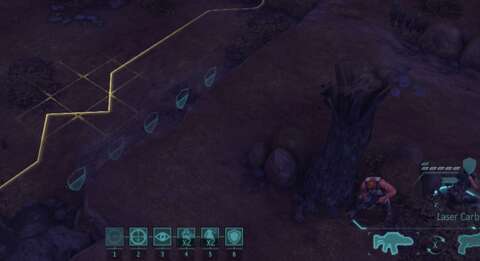
COMMAND CHARGES:
The other main reason to have an officer leading a mission is the set of command charges that he/she has. Higher-ranked officers have more charges.
A charge can directed at a soldier that is in sight of the officer and whose turn has ended; the soldier is reactivated again for one more action. Using a charge will end the officer’s turn, however.
The officer is essentially passing his/her turn to someone else that may be able to do more. However, there are a few limitations to prevent this from being too tactically advantageous. One limitation, in particular, is that a Command Charge will not reset any variables that the other soldier has incurred, such as having moved previously in that round or having fired a rocket already.
OFFICERS CANNOT BE PSIONICS OR MECS:
The main limitation with officers is that they cannot be Psionics or MECs. In contrast, the Medals in the vanilla version can be given to anyone, including MEC soldiers (who are clearly augmented despite the ceremonial uniform covering most of their limbs. The converse also applies, so the player will want to plan for which soldier gets to be a Psionic, Officer or MEC.
However, Officers can still be genetically enhanced. This is a significant investment, however, such that a loss of an officer can be considerable.
PSIONICS – OVERVIEW:
Rookie soldiers cannot be tested for Psionic potential in the Long War. They need to get some experience first before they can be tested; an additional meter that is next to their experience meter shows this progress.
Unlike in the vanilla version, testing for Psionic potential is not affected by the number of extant Psionics among the XCOM roster. However, the chance of awakening Psionic potential is still low, though soldiers who fail can be tested again. This is perhaps the most fickle part about Psionics that the Long War does not address.
On the other hand, Psionics in the Long War have far more options and greater potency than those in the vanilla game. They also have access to more Psionics-only gear. For example, there is an item that can greatly increase the Aim rating of a Psionic and the chance to get critical hits, in return for reducing their Will.

INCREASED FATIGUE:
However, Psionics do have some setbacks that prevent them from being readily fielded in missions. Firstly, presumably due to the strain of having powers that the human mind does not readily have, Psionics suffer from longer fatigue periods. Each power that they gain increases the fatigue time. On the other hand, a late-game suit – the Vortex suit – renders them immune to fatigue.
POWERS NOT INITIALLY AVAILABLE:
Psionics no longer get additional powers automatically upon having gained levels in their psionic talent. Rather, the training data for additional powers must be obtained from conducting autopsies of specific alien species (usually the psionic ones) and the interrogation of live captures. The latter method in particular unlocks more psionic powers.
Furthermore, a Psionic does not get to obtain a power upon having met the requisite amount in psionic experience. Rather, the Psionic has to be sent to the labs again to be trained in the use of an additional power. This also depends on an RNG roll against a threshold, unfortunately.
PSIONICS CAN BE GENETICALLY ENHANCED:
Psionics can be genetically enhanced, with the exception of the Neural Damping enhancement, which precludes anyone with this enhancement from becoming a Psionic. However, genetic enhancements do increase the Fatigue time from missions.
OVERHAULED MECS & SHIVS:
MECs and SHIVs have also been overhauled. In particular, their parts have to be individually built and equipped onto them; there are no Foundry projects to upgrade their weapons permanently. These pieces of equipment, especially the suits and the guns, are quite expensive to build.
However, there are Foundry projects that improve their other capabilities, such as giving them significantly more movement distance and ablative hit points. This makes MECs and SHIVs – SHIVs in particular – very good damage sponges and more tactically versatile.
Turning a soldier into a MEC operator also applies the fatigue setback to them. However, a MEC suit can be used by more than one operator.
GEAR DAMAGE AND REPAIRS:
Guns, armor and tools can suffer damage after missions, usually due to their user getting injured (or killed). These damaged items cannot be used and cannot be sold off either. Thus, they have to be repaired.
Incidentally, the MEC bay in Enemy Within has been reworked into the repair bay for this purpose. There are some visual artifacts from this change, such as the silhouette of a MEC suit appearing in the MEC bay’s user interface.
Repairs cost Alien Alloys and some money, both of which the player would need in the long term. Therefore, the player will want to avoid casualties where possible (and avoid using one of the Second Wave settings that the Long War implements; there will be more on these later).
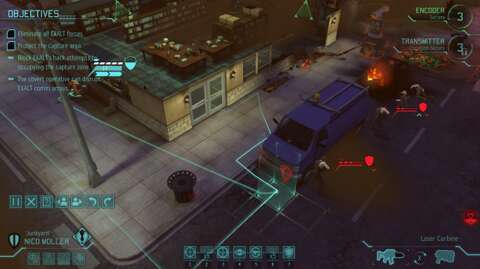
ALIEN VARIANTS:
The Long War implements variants for the same type of alien; this is in addition to those that have been introduced in the Enemy Within.
In particular, there are the variants that have been implemented as specific members of a “pod” of aliens (to use the term that the XCOM community of developers and players have used to describe groups of aliens). The changes that Long War implements to the gameplay designs of pods will be described later.
That said, the variants tend to be more powerful. For example, there are enhanced Thin Men who have the Lightning Reflexes and Executioner perks.
However, they will otherwise still behave in the same way as the originals; this is mainly due to limitations in animating them. For example, since the mod creators could not implement grenade-throwing animations for Thin Men, Thin Men would not be throwing grenades.
PODS – OVERVIEW:
As a reminder, “pods” are groups of aliens that move about in the mission area. In the Long War mod, they have been heavily altered to be both more challenging and easier to deal with.
SQUAD COHESION:
In the vanilla version, two pods may be activated and they would just work with each other like they are part of the same squad; this means that the player would likely be overwhelmed if the player activates too many pods.
In the Long War, pods behave more like squads, specifically in how each individual enemy would make its decisions with regard to the other members in the same pod.
For example, in the case of a pod of Mutons, the member with the most hit points would rush forward to trigger Overwatch shots so that another member of the same pod can move into place to toss its grenade to destroy cover that the XCOM operatives are using. A third Muton from the same pod would then move into place to shoot any XCOM soldier that has been exposed.
All this happens before the CPU-controlled opponent continues to another activated pod. In the vanilla version of the game, the opponent would move whichever alien that gives the most advantage, regardless of its pod.
In Long War, if a pod has been decimated down to the last individual, the survivor might just break and attempt to run away and cower. The last survivor has to make a Will check every turn in order for the CPU-controlled opponent to even use it for tactical maneuvers; if it fails the check, it stays in place and does nothing.
MIXED PODS:
The Long War allows the CPU-controlled enemy to field pods with mixed types. For example, there may be a pod with Thin Men and Sectoids, and maybe even a Drone. Although this dilutes the potency of each type, this does give the pod more tactical options. For example, Sectoids can always use their Mind Merge on some other species that is more durable than they are.
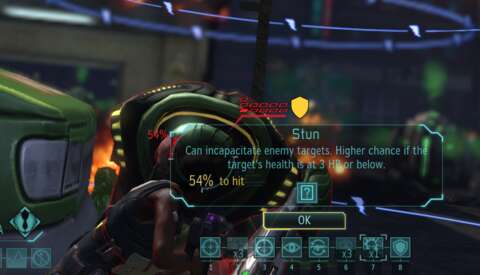
NAVIGATORS & LEADERS:
Another innovation that the Long War implements is the roles of Navigator and Leader. The Navigator is generally the member with the highest amount of mobility and defense, and is coded to almost always try to outflank the XCOM soldiers. The Navigator is also almost always at the front of the pod, when they have not been activated.
The Leader is always the member with the highest amount of hitpoints, in the case of pods with homogeneous species. It might even be an enhanced variant of the species.
Tactically, the Leader would not be doing much for the pod; it does not have Command Charges. Rather, it is a liability as much as it is the strongest asset in the pod. If the Leader goes down, the pod is much more likely to break when it gets whittled down to less than half of its original number. Of course, being a damage sponge, the Leader would be taking disproportionately more fire from XCOM soldiers.
ACTIVATED PODS ARE STILL OMNISCIENT:
In the vanilla game, pods that have been activated are aware of the exact locations of XCOM operatives, their lines of sight and whether they are on Overwatch or not. For better or worse, this is still the case with the pods in Long War. Pods that have many members will use this advantage in incredible and perhaps even unfair manners, such as getting behind cover that is just at the edges of the XCOM soldier’s vision.
(That said, just entering the vision of a character on Overwatch but not moving any further does not trigger the Overwatch fire. Moving away to immediately leave that vision zone without moving through it also does not trigger Overwatch.)
POISON CHANGED TO ACID:
In the vanilla game, Thin Men spit poison clouds, which made Thin Men far more annoying and dangerous than they should be. The Long War changes their poisonous fluids to acidic ones.
The acid clouds inflict the “Acid” status onto anything that passes through them, unless they happen to be immune. The de-buff does not have a damage-over-time effect, which was the main frustration with the original poison clouds.
Rather, any organic victim with the de-buff must make an RNG roll whenever they do anything other than Hunker Down; if they fail this roll, they take one point of damage. Hunkering Down prevents this damage, but of course prevents them from doing anything else. The de-buff also impairs their attack rolls. On mechanical characters, the Acid de-buff also impairs their attacks, but also diminishes the damage reduction from their armor.
GEOSCAPE OVERHAULS – OVERVIEW:
The Long War also implements changes in the gameplay of the Geoscape. However, these changes are less significant than those elsewhere in the game, likely due to the need to use existing visual assets for the Geoscape.
MORE NATIONS & CONTINENTS:
There are more nations and continents in the Long War. Although this means more nations to worry about, this also means more income opportunities and continental bonuses.
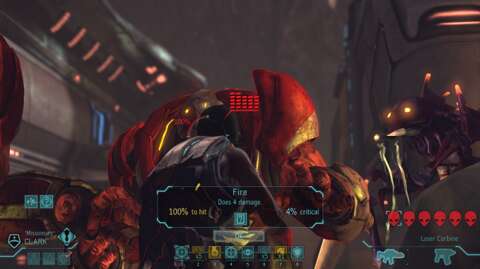
INTERCEPTORS CAN DETECT UFOS TOO:
In the vanilla game, only satellites can detect UFOs. Thus, there is no reason to have interceptors on continents without satellites.
In the Long War, interceptors in continents without satellite coverage can potentially detect UFOs too (presumably through practice sorties). However, this only happens if they succeed at a RNG roll with a low threshold of success. On the other hand, each interceptor can make a roll.
Nevertheless, the player should have a satellite or more in a continent. After all, satellites remain reliably capable at detecting UFOs.
INTERCEPTORS CAN GAIN EXPERIENCE:
Perhaps the greatest difference that the Long War makes with regard to aerospace combat is that interceptors can get better with more UFO kills. Specifically, every UFO knock-out that an interceptor carries out gives it a bonus to its probability at landing hits, and a bit more damage inflicted for those hits.
The ability of an Interceptor at protecting itself is not improved in any way, however. Furthermore, the bonuses reach a cap at 10 kills. The kills are not exchangeable between interceptors either; pilots are not transferable between different crafts.
UFOS CAN BE COMPLETELY DESTROYED:
In the vanilla game, UFOs always crash when downed. In the Long War, there is a possibility that downed UFOs are destroyed utterly, yielding little salvage. The possibility of this happening depends on the strength of the knock-out blow, i.e. damage that is inflicted in excess of the UFO’s remaining hitpoints prior to the final hit will determine that possibility.
This is not an entirely welcome difference. Although the player is compensated through the awarding of bounties by the Council of Nations, the infusion of money will not make up for the loss of the opportunity to gain physical resources from the remains of the downed UFOs.
MORE UFO TYPES:
The types of UFOs have been expanded, making use of visual assets and map designs that have been in Enemy Within. Some of these UFOs are meant for very specific missions. For example, the Raider is meant for harvesting missions and the Destroyer is meant to knock out XCOM satellites. Consequently, there are also more research projects to analyze them for increased damage against them and increased salvage from securing them after they have been downed.
DATA OF UFO DAMAGE CAN BE MADE AVAILABLE:
In the vanilla version of the game, the player does not have many ways of knowing when a UFO is going to be downed. In the Long War, there is a Foundry project that can be completed in order to yield this data. This is just as well, because the player needs to manage the downing of an UFO if the player wants a downed UFO to be intact.
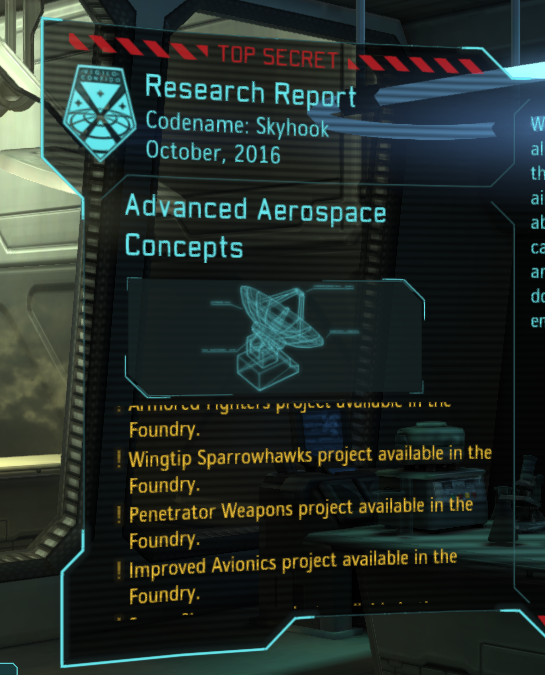
STILL SAME OLD AEROSPACE COMBAT:
Unfortunately, aerospace combat is still a conflict that occurs between an Interceptor and a UFO. Even Long War does not acknowledge the practicality of sending a supersonic cruise missile after a UFO instead of an interceptor that may be terribly outmatched.
That said, once battle is joined between an Interceptor and a UFO, the battle is still decided by RNG rolls. The UFO makes rolls against a threshold of success, whereas the Interceptor does the same. The Long War is more transparent about the probabilities of success, but luck is still the most significant factor anyway.
Indubitably, the Long War mod only emphasizes why the second XCOM title does not have aerospace combat.
MANY, MANY MISSIONS:
The main reason for the Long War mod is that the campaign in the vanilla game was just too short, at least for players who remember the classic games. The Long War mod addresses this by greatly increasing the number of research and Foundry projects, not just for the additional content. These projects also have much higher costs than those in the base game.
In turn, the player has to down more UFOs and secure them through recovery missions. Indeed, many of the missions that the player would play would involve securing downed UFOs.
Indubitably, there is the ironic complaint that the Long War mod just makes the campaign too long. Burnout is a major possibility when playing Enemy Within with this mod.
SECOND WAVE SETTINGS:
Updates for Enemy Unknown implemented optional settings that can be activated for slightly different gameplay experiences. The Long War doubles down on these. More importantly, the mod makes available all of them, without the player having to unlock them through winning playthroughs with specific conditions.
For example, there is “Liberation”, which requires all nations to be freed from alien influence and participating in the XCOM project in order for the Endgame scenario to be made available. Another (much more welcome) setting is “Perfect Information”, which shows the probabilities of success for all RNG rolls during a mission.
The Long War also revamps some of the settings. For example, the “Not Created Equally” setting has been replaced with “Strict Screening”, which just fixes the starting statistics of rookies to the averages of the variable ranges that would otherwise have been used.
Curiously, Long War also removes some of the settings that would make a playthrough very difficult, such as the “E-115” setting that makes collected Elerium disappear over time.
Another notable setting is “Dynamic War”, which readjusts some things to reduce the number of missions that the player would need to undertake in order to progress in the campaign.
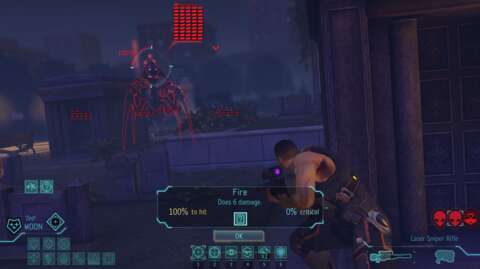
VISUAL CHANGES:
Unfortunately, visual changes are perhaps where the Long War mod falters at. Granted, the people who worked on the mods do not include most of the model animators or effects designers at Firaxis. Still, the visual changes that were implemented have the game looking goofy at times.
Quite a number of the images that represent the new weapons in the loadout screens have been pulled from the second game. Otherwise, these are screenshots of weapon models that have been altered. This would have been okay, if not for the fact that the actual 3D models of the weapons do not look like these at all.
Rather, the models are resized versions of the models that have been in the vanilla game. Of course, it would be understandable if the reason for this is that re-rigging models and updating their animations is beyond the skill and scope of the mod creators. Still, this is a disappointment.
AUDIO CHANGES:
The Long War also implements audio changes. There are some more voice packs, though these are actually those that did not make it into the original package of the vanilla game. Some voice-overs are disappointingly flaccid, such as the South African and Australian ones. Furthermore, some omissions are still noticeably around, such as the lack of voice-overs in Oriental languages.
As for new sound effects, some of these have been adapted from the second game, such as the sounds of Mag guns firing, which have been used for Gauss weapons in this mod.
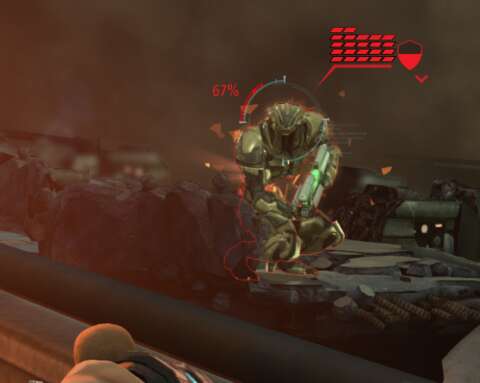
SUMMARY:
The Long War greatly improves the complexity of the gameplay in the vanilla XCOM games. Unfortunately, it does not address the fickle parts of the gameplay. Furthermore, the Long War may have over-reached its objective of making the gameplay last longer.
